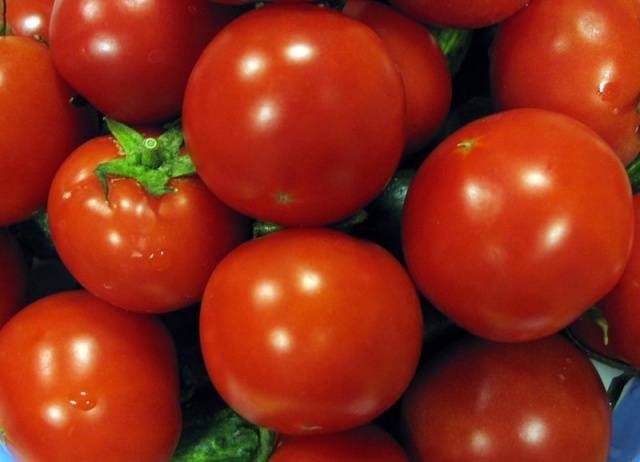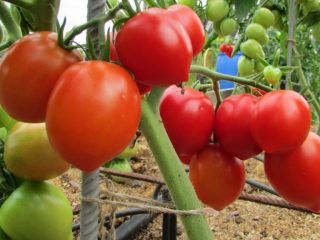Content
The Astrakhan tomato variety is included in the state register for the Lower Volga region. It can be grown indoors and outdoors. The variety is distinguished by its unpretentiousness, compact bush size and high yield.
Features of the variety
The characteristics and description of the Astrakhan tomato variety are given below:
- determinant species;
- plant height from 65 to 80 cm;
- fruiting in the mid-early period;
- from the emergence of seedlings to the formation of fruits, it takes from 115 to 122 days;
- compact standard bush;
- the first inflorescence appears above the 7th leaf.
The fruits of the Astrakhan variety have a number of features:
- round shape;
- average weight from 100 to 300 g;
- Smooth surface;
- ripe tomatoes are red;
- fleshy and tasty fruits;
- not prone to cracking.
Productivity of the variety
The average yield of the Astrakhan variety is 600 c/ha. The variety has abundant fruiting. According to its characteristics and description, the Astrakhan tomato variety is suitable for preparing snacks from fresh vegetables, soups, main courses and sauces. It is used in homemade preparations whole or sliced.
Boarding order
The Astrakhan variety is used for planting in open areas or in greenhouse conditions.Seedlings are first obtained, which are then transferred to selected areas. Seedlings need good lighting and watering. The soil for planting tomatoes must be dug up and fertilized.
Growing seedlings
The soil for planting Astrakhan tomatoes begins to be prepared two weeks before work. It is obtained by combining equal proportions of turf and compost. It is recommended to prepare the soil in the fall or purchase a ready-made mixture for growing tomatoes.
If the soil is too heavy, add peat or coarse sand. A non-standard option for growing seedlings is to use coconut substrate. In it, tomatoes form a healthy root system, and the seedlings themselves develop quickly.
A day before planting, it is necessary to prepare the seeds of the Astrakhan tomato variety, which are placed for a day in a saline solution (1 g of salt per 0.2 liter of water). After this treatment, shoots appear faster.
Containers with a depth of 10 cm are prepared for the seedlings. Soil is poured into them, in which furrows are made 1 cm deep. Seeds of the Astrakhan variety are placed in 2 cm increments, which need to be sprinkled with soil.
Until the first shoots, tomatoes are kept in a dark place at a constant temperature of 25-30 degrees. When sprouts appear, the containers are moved to a lighted place. For 12 hours, plants are provided with access to light. Periodically water the tomatoes with warm water.
Planting in a greenhouse
The soil in the greenhouse is prepared in the autumn.Up to 10 cm of the top layer of soil must be removed, since spores of fungal diseases and harmful insects overwinter in it. The remaining soil is dug up and added 1 m2 fertilizers: superphosphate (6 tbsp), potassium sulphide (1 tbsp) and wood ash (2 cups).
The greenhouse for growing tomatoes is located in a well-lit area. It is covered with film, polycarbonate or glass. Be sure to provide vents for ventilation. Tomatoes are grown in one place every 3 years.
For the Astrakhan tomato variety, planting holes up to 20 cm deep are prepared to place the root system of the plants in them. Since the variety is low-growing, the tomatoes are arranged in a checkerboard pattern. This scheme makes it easier to care for tomatoes and allows you to control the density.
Leave 20 cm between plants, and up to 50 cm between rows. After planting, the tomatoes are watered abundantly. Over the next week, do not add moisture or fertilizing; it is enough to periodically loosen the soil and hill up the tomatoes.
Planting in open ground
According to reviews, Astrakhan tomato can be grown in open beds in the southern regions. You can use the seedling method or plant the seeds directly in open ground. If the second method is used, the growing process will take longer.
For tomatoes, beds are prepared where onions, beets, cabbage, carrots, herbs, and legumes previously grew. It is not recommended to plant tomatoes in one place for two years in a row, or to use areas after eggplants, potatoes, and peppers.
The soil in the beds is dug up in the fall, plant remains and other debris are removed. Be sure to add compost or rotted manure. In spring, it is enough to deep loosen the soil.
Tomato seedlings are transferred to the depressions, leaving an earthen lump. Then the root system needs to be sprinkled with earth and the surface compacted a little. The final stage is to water the tomatoes abundantly.
Tomato care
The Astrakhan tomato requires minimal care, which consists of watering and fertilizing. The variety is resistant to tobacco mosaic virus and Egyptian broomrape, and rarely suffers from blossom end rot. It is recommended to tie the bushes to form even stems and prevent the tomatoes from coming into contact with the ground.
Watering the plantings
The Astrakhan variety requires moderate watering. Soil moisture is maintained at 90%. At the same time, the air in the greenhouse must remain dry, which is ensured by ventilating the greenhouse.
Each bush needs 3-5 liters of water. Lack of moisture leads to falling inflorescences, yellowing and curling of the tops. Its excess slows down the development of plants, causes rotting of the root system and provokes fungal diseases.
For irrigation, use water that is warm and has had time to settle. It is applied strictly at the root to avoid contact with the roots and tops of tomatoes. The procedure is carried out in the morning or evening, when there is no direct rays of the sun.
The first watering is carried out on the 10th day after transferring the tomatoes to the garden bed.During this period, active growth of tomatoes begins, but their root system is not yet developed enough to receive moisture from the deep layers of the soil.
Before flowering, tomatoes are watered twice a week with 2 liters of water. When flowering, tomatoes require 5 liters of water every week. When fruits appear, the frequency of watering is increased to 2 times a week.
Fertilizer application
Fertilizing promotes the development of Astrakhan tomatoes and increases their yield. In total, tomatoes are fed several times during the season. You can use both mineral fertilizers and folk remedies.
The first feeding of tomatoes is done a week after transferring the seedlings to a permanent place. It is recommended to apply nitrogen fertilizers in limited quantities at this stage, since they contribute to excessive growth of green mass.
During the flowering period, prepare a 1% solution of boric acid (1 g per 10-liter bucket of water). Plantings are sprayed with it to stimulate fruit formation and prevent the ovaries from falling off.
Feeding with ash will help replace minerals. It is embedded in the ground or an infusion is prepared based on it (a tablespoon per liter of hot water). Wood ash contains a complex of minerals, including calcium, potassium, and magnesium.
Reviews from gardeners
Conclusion
The Astrakhan variety is a low-growing tomato that requires a minimum of care. These tomatoes are characterized by good yield, and the fruits are suitable for preparing dishes for daily consumption and home canning.















